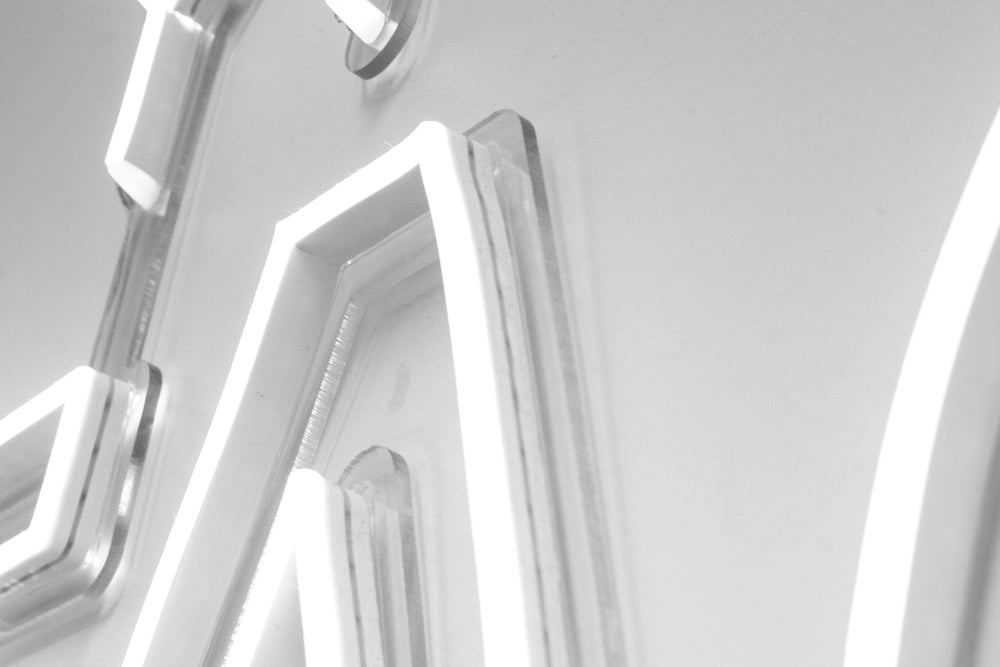Introduction
LED neon signs are a fantastic way to add a pop of colour and personality to any space. Whether you’ve just purchased a new LED neon sign for your business, home, or event, or you’re looking to relocate an existing one, knowing how to properly mount it on a wall is crucial.
Proper installation ensures that your sign looks great and is securely mounted. This guide will walk you through the steps to wall-mount your LED neon sign, covering the tools you’ll need, safety precautions, and best practices for a secure installation.
Tools and Materials You’ll Need
Before you start, gather the necessary tools and materials:
-
Screws and ceiling/wall anchors
-
Measuring tape
-
Pencil
-
Level
-
Drill with appropriate drill bits
-
Screwdriver
-
Mounting clips or brackets (if required)

Safety Precautions
Hanging an LED neon sign involves handling electrical components. Follow these safety precautions to avoid accidents:
Turn Off the Power: Before handling the sign, ensure that it is unplugged, and the power is turned off to prevent electrical accidents during installation.
Check the Weight: Ensure that the wall or surface where you plan to hang the sign can support its weight. For heavier signs, use heavy-duty hooks, brackets, or anchors for extra security.
Avoid Moisture: If you’re hanging the sign in a location exposed to moisture (e.g., outdoor spaces or bathrooms), ensure the sign is rated for such environments, and all electrical components are properly insulated.
Step-by-Step Guide to Wall Mounting a Neon Sign

Choose the Location
Step 1: Choose the Ideal Location
Select the best spot on the wall to mount your LED neon sign by considering visibility, height, and the background. Ensure the location allows easy access to a power source, especially if the sign will be permanently plugged in. If needed, position the sign near power outlets and manage cabling discreetly.
Step 2: Plan Power Access
Ensure that power adaptors and LED controllers are kept out of sight for a clean appearance. Ideal locations for hiding these components include areas behind furniture, in ceiling and wall cavities, or other areas away from foot traffic to ensure both safety and neatness.
Step 3: Position for Maximum Impact
For optimal visibility, position the sign at eye level or slightly above. This makes the sign easily viewable while enhancing its visual impact in the space.
Measure and Mark the Spots
Step 4: Measure the Installation Location
Use a measuring tape to determine the exact spot on the wall where you want to mount your LED neon sign. Ensure the position aligns with your desired height and visibility. For larger signs, using a level will help ensure a straight, professional-looking installation.
Step 5: Mark the Mounting Points
Place your neon sign on the wall at the measured location, and use it as a stencil. With a pencil, mark the spots where screws or mounting hardware will go. Double-check the markings for alignment and accuracy before proceeding.

Drill Holes for Mounting
Step 6: Prepare for Heavy Signs or Tough Surfaces
If your sign is heavy or if you’re mounting it on tough materials like brick or concrete, you’ll need to drill holes for wall anchors. These provide extra support, ensuring the sign stays securely in place.
Step 7: Drill the Holes
Using a drill, create holes at the points you marked in Step 5. For LED neon signs, ensure the holes align with the mounting points on the sign's acrylic backboard. Double-check the alignment before drilling to ensure the sign will hang straight.

Install Anchors or Hooks
Step 8: Insert Wall Anchors
If necessary, insert wall anchors into the drilled holes. This step is crucial for heavier signs or when mounting on surfaces like drywall, brick, or concrete, as the anchors provide additional support and prevent the hardware from loosening over time.
Step 9: Attach the Mounting Hardware
Screw the mounting hardware into the anchors or directly into the wall. Ensure everything is securely fastened to support the weight of your LED neon sign. Double-check that the hardware is level and firmly attached before moving on to the final installation steps.

Mount the LED Neon Sign
Step 10: Position the LED Neon Sign on the Wall
Carefully lift the LED neon sign and align the pre-drilled holes, typically located in the four corners, with the installed wall anchors.
Step 11: Secure the Sign
Once aligned, ensure the sign is level and evenly distributed. The sign should sit flush against the wall. Make necessary adjustments to ensure stability and proper alignment.

Connect to Power
Step 12: Connect the LED Sign and Controller to a Power Source
Once the LED neon sign is securely mounted, connect it to the LED controller. Ensure the controller is properly connected to both the sign and the power source. Then, plug the sign into a standard outlet. Double-check that all connections are secure, and position the power adaptor safely out of sight.
Step 13: Pair the Remote and Store the Controller
Before storing the LED controller, pair the remote control with the sign following the manufacturer's instructions. Once paired and tested, store the controller in a safe location, such as behind furniture or in a secure area away from foot traffic. Ensure all wiring is neatly organised and tucked away to complete the installation.
Test the Sign
Step 14: Test the Sign
Turn on the power to test your LED neon sign. Ensure it lights up evenly with no flickering or dimming. Inspect the sign for any issues with brightness or alignment. If everything looks good, your sign is ready to shine! Enjoy your new display.

Common Mistakes to Avoid
Overloading Wall Anchors: Make sure the wall anchors or mounting hardware can support the weight of the sign. Using the wrong type or size of anchors can result in the sign falling and potentially breaking.
Incorrect Placement: Be sure to measure and mark the spots accurately. If the sign isn’t level, it can look unprofessional and may even strain the mounting hardware, increasing the risk of it coming loose over time.
Ignoring Power Source Location: Ensure the sign’s power cord can reach the nearest outlet without needing an extension cord, which can look messy or create a tripping hazard.
Poor Insulation: For outdoor installations, ensure all electrical components are adequately insulated and weatherproof to prevent damage from moisture or temperature changes.

Conclusion
Wall-mounting an LED neon sign is a straightforward process when you take the time to prepare properly and follow the necessary safety precautions. By ensuring the sign is securely mounted, aligned, and correctly connected to power, you can confidently display your custom LED neon sign in any space. Following these steps will guarantee that your sign not only looks great but also remains safe and durable for years to come.




